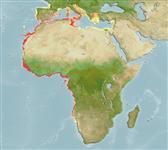Actinopterygii (ray-finned fishes) >
Clupeiformes (Herrings) >
Clupeidae (Herrings, shads, sardines, menhadens) > Dorosomatinae
Etymology: Sardinella: Latin and Greek, sarda = sardine; name related to the island of Sardinia; diminutive (Ref. 45335).
Environment / Climate / Range
Ecology
Marine; brackish; pelagic-neritic; oceanodromous (Ref. 51243); depth range 0 - 80 m (Ref. 27000). Subtropical; 24°C - ? (Ref. 54872), preferred 24°C (Ref. 107945); 46°N - 23°S, 17°W - 36°E (Ref. 54872)
Atlantic Ocean: eastern Atlantic Ocean from Gibraltar southward to Angola, with a single specimen reported from Walvis Bay, Namibia (Ref. 188, 81269). Also known from Mediterranean Sea in the southern and eastern parts, penetrating also the Suez Canal (Ref. 188).
Length at first maturity / Size / Weight / Age
Maturity: Lm 13.4, range 11 - 19.5 cm
Max length : 30.0 cm SL male/unsexed; (Ref. 188); common length : 25.0 cm SL male/unsexed; (Ref. 188); max. published weight: 927.00 g (Ref. 3808)
Dorsal
spines
(total): 0;
Dorsal
soft rays
(total): 18-21;
Anal
spines: 0;
Anal
soft rays: 17 - 23. Diagnosis: Body elongate, but variable in depth, belly fairly sharply keeled; total scutes 31-34 (Ref. 188, 81269). Lower gillrakers 70-166 (Ref. 188, 81269). Upper pectoral fin rays white on outer side, the membrane between black (Ref. 188). Sardinella maderensis resembles S. aurita, but pelvic fin with 1 unbranched and 7 branched rays and no black spot on hind part of gill cover, but a faint gold or black area just behind gill opening (Ref. 188). It is distinguished from S. rouxi by having more lower gillrakers, only 30-40 in S. rouxi, and the caudal fin grey, its tips almost black vs. yellow in S. rouxi (Ref. 188).
Forms schools in coastal waters, preferring waters of 24°C. Feeds on a variety of small planktonic invertebrates, fish larvae and phytoplankton. Breeds during the warm season (July-September). Juveniles and adults show clear north-south migrations in the Gabon-Congo-Angola sector of their range and also in the Sierra Leone-Mauritania sector, each area having nurseries. The movements are correlated with the seasonal upwelling. Marketed fresh, frozen or salted.
Life cycle and mating behavior
Maturity | Reproduction | Spawning | Eggs | Fecundity | Larvae
Whitehead, P.J.P., 1985. FAO Species Catalogue. Vol. 7. Clupeoid fishes of the world (suborder Clupeioidei). An annotated and illustrated catalogue of the herrings, sardines, pilchards, sprats, shads, anchovies and wolf-herrings. FAO Fish. Synop. 125(7/1):1-303. Rome: FAO. (Ref. 188)
IUCN Red List Status (Ref. 115185)
CITES (Ref. 94142)
Not Evaluated
Threat to humans
Harmless
Human uses
Fisheries: highly commercial; bait: usually
More information
ReferencesAquacultureAquaculture profileStrainsGeneticsAllele frequenciesHeritabilityDiseasesProcessingMass conversion
Tools
Special reports
Download XML
Internet sources
Estimates of some properties based on models
Phylogenetic diversity index (Ref.
82805): PD
50 = 0.5000 [Uniqueness, from 0.5 = low to 2.0 = high].
Bayesian length-weight: a=0.00851 (0.00687 - 0.01055), b=3.02 (2.98 - 3.06), in cm Total Length, based on LWR estimates for this species (Ref.
93245).
Trophic Level (Ref.
69278): 3.2 ±0.38 se; Based on food items.
Resilience (Ref.
69278): Medium, minimum population doubling time 1.4 - 4.4 years (K=0.34; tm=3; tmax=6).
Prior r = 0.82, 2 SD range = 0.42 - 1.59, log(r) = -0.2, SD log(r) = 0.33, Based on: 1 M, 11 K, 1 tgen, records
Vulnerability (Ref.
59153): Low to moderate vulnerability (33 of 100) .
